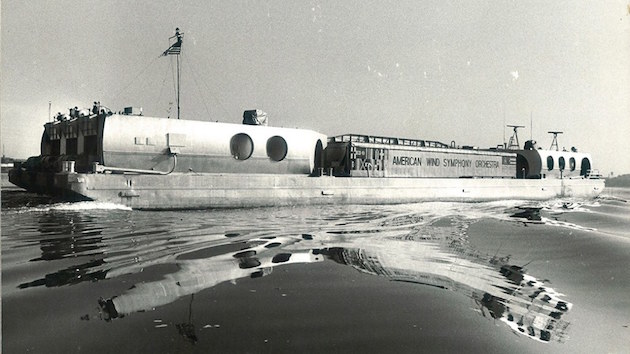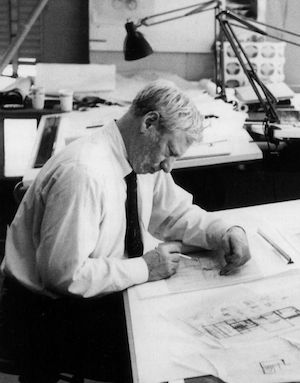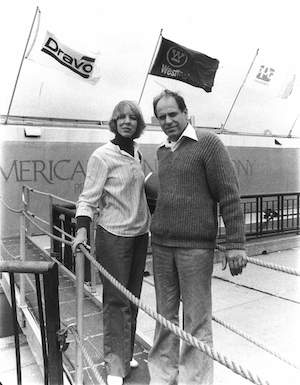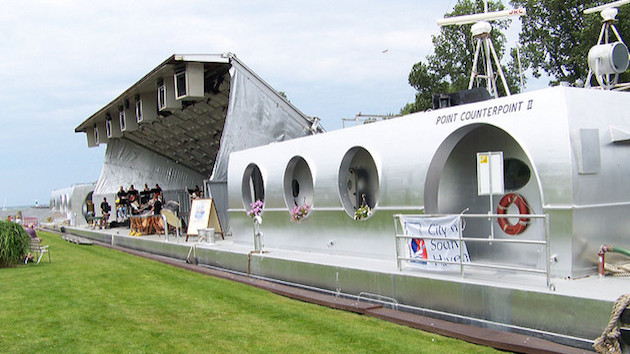
Johann Wolfgang von Goethe once quipped that “architecture is frozen music.” In this case, it’s more like floating music.

Louis Kahn, one of the most significant architects of the 20th century, is best known for his monumental works such as the Parliament of Bangladesh and meticulously crafted smaller structures including the Salk Institute in La Jolla, California, and the Kimbell Art Museum in Fort Worth, Texas. Lately the arts media have been aflutter with news about one Kahn project rarely mentioned in the coffee-table books and monographs: Point Counterpoint II, a 195-foot floating concert hall designed for conductor Robert Austin Boudreau and his American Wind Symphony Orchestra.
Robert Boudreau founded the peripatetic ensemble in 1957 with an eye toward taking music to the people by way of America’s inland and coastal waterways. The orchestra would pull up to a friendly shore, set up on deck, and perform. In the early years their conveyance was a rudimentary stage on a barge that was towed from dock to dock — initially along the Ohio, Cumberland, Tennessee, and Mississippi Rivers.

In the ’70s, Boudreau commissioned Kahn to design a self-contained, self-propelled concert stage with a pop-up clamshell roof plus a mobile museum with an on-board theater for children, exhibition spaces, workshop rooms, and crew facilities. The project was completed in time for the bicentennial — two years after Kahn’s death.

In an interview with NPR’s Scott Simon, Boudreau said, “The SS Point Counterpoint II looks like a figment of Captain Nemo's imagination or a leftover prop from Star Wars.” Since its launch, the Point Counterpoint II has landed in hundreds of destinations throughout the U.S., Canada, Mexico, the Caribbean, and throughout northern Europe, and provided a solid platform for international musical diplomacy. Along the way, Boudreau commissioned more than 400 new compositions for his ensemble, many of them recorded on the AWSO’s 10 CDs.
In recent years the barge has started showing its age, and has required some major repairs to its propulsion system. The owners, Boudreau and his wife, Kathleen, are feeling the pinch of time, too. Boudreau just turned 90, and after 60 years with the AWSO — 40 years of that aboard the Point Counterpoint II — the couple has decided they need to part ways with their beloved craft.
There have been numerous murmurings about permanent retirement sites for the barge, including interest in Chicago for its downtown Riverwalk, a museum in New Haven, Connecticut, and even in Tallinn, Estonia, where a developer tried to raise funds in honor of Kahn’s Estonian roots. To date, no solid offer has been made, and there are plans for the barge to make its way to a Louisiana shipyard where it will be broken down to scrap.
A recent letter from Yo-Yo Ma to The New York Review of Books urged efforts to save the landmark:
At a time when our national conversation is so often focused on division, we can ill afford to condemn to the scrap heap such a vibrant ambassador for our national unity, so I humbly ask that your readers join Robert and me in finding a new home for Point Counterpoint II. Please share any suggestions with Robert and Kathleen at awso@consolidated.net.

The cellist’s plea may have found a receptive audience. Tuesday’s Chicago Tribune reports that, “Officials and activists in the Hudson River town of Kingston, N.Y., plan to meet with the boat's owner Aug. 4 to discuss the possibility of transporting the vessel there from its current berth on the Illinois River in Ottawa, Ill.”
There is still the matter of raising the $2 million to pay for the boat and logistics to resolve regarding its location, but for the moment, anyway, Robert Boudreau’s dream is still afloat.

